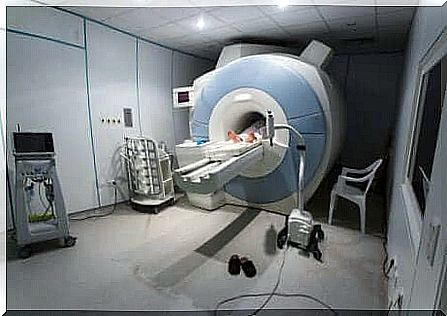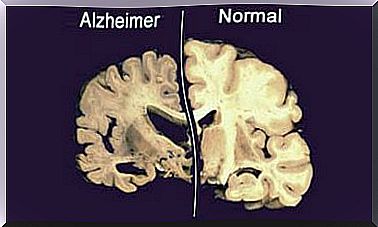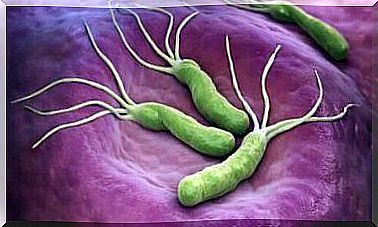Carcinoid Syndrome: Causes, Symptoms And Treatment
Carcinoid syndrome is characterized by hot flashes, hot flashes, tachycardia and diarrhea, among other symptoms. We explain why they appear and how they can be treated in oncology.

Carcinoid syndrome refers to a set of signs and symptoms that can appear as a complication of certain tumors. These are carcinoid tumors, which are able to secrete chemicals such as serotonin.
Although not the most common type of cancer, these tumors and carcinoid syndrome can be very aggressive. Many people experience shortness of breath or tachycardia. This article explains everything you need to know about it and how this disorder is treated.
What is carcinoid syndrome?
Carcinoid syndrome is a collection of signs and symptoms that are caused by the action of certain substances released by a tumor. According to an article published in Revista Médica de Costa Rica y Centroamerica, most carcinoid tumors develop from neuroendocrine cells in the gastrointestinal tract.
In fact, it is estimated that about 50% of all cancers of the small intestine are of this type. However, they can also occur in the lung, pancreas, and liver. However, carcinoid syndrome only affects about 8% of people with these tumors.
It most often occurs when there is extensive metastasis in the liver. The tumor releases substances such as serotonin, histamine, and prostaglandins. All of these substances can act in many parts of the body and produce the characteristic symptoms.
Symptoms of carcinoid syndrome
According to specialists at the Mayo Clinic, one of the most common symptoms is redness of the skin. It usually affects the face and the upper part of the chest. This is because many of the substances mentioned cause vasodilation.
The redness appears suddenly and lasts for a few minutes to a few hours. It is sometimes triggered by certain agents that also cause vasodilation, such as exercise or alcohol. It is accompanied by hypotension, dizziness and fatigue.
Another common symptom is diarrhea. Especially when the tumor releases serotonin, because it acts on intestinal motility. The stools are usually watery and abdominal cramps may occur.
Carcinoid syndrome is also manifested by tachycardia and shortness of breath. It is similar to an anxiety attack. Some people experience decreased libido, heart murmurs and extra breath sounds.

Possible complications
Carcinoid syndrome can lead to many complications. According to a study published in Revista Chilena de Cardiología, one of the most relevant is carcinoid heart disease. It occurs because plaques of fibrous tissue form on the heart valves.
More specifically, the areas most affected are the right heart valves (tricuspid and pulmonary). This leads to heart failure which develops over time.
Another very important complication is the carcinoid crisis. It occurs when the syndrome is made worse by a trigger and symptoms intensify. For example, when anesthetics are used for surgery. Blood pressure can drop too low and lead to fatal shock.
Bowel obstruction is also a complication of carcinoid syndrome. However, it tends to arise from the tumor itself. When it becomes large or spreads to the lymph nodes, the intestinal loops can turn on themselves.
What are the causes of carcinoid syndrome?
The signs and symptoms that characterize carcinoid syndrome itself are caused by substances produced by the tumor. These are the ones we mentioned previously: serotonin, histamine, prostaglandins.
The explanation for why carcinoid syndrome does not occur in all tumors is that the liver usually neutralizes these chemicals before they take effect. However, in cases where liver metastases are numerous, the organ is damaged.
Risk factors for liver cancer
The main risk factor for carcinoid syndrome is clearly having a carcinoid tumor. At the same time, certain circumstances can increase the likelihood of developing this type of cancer.
The main indicator is having a family history of the same type of tumor. And if there are cases in the family of multiple endocrine neoplasia 1 or type 1 neurofibromatosis.
As carcinoid tumors usually grow in the digestive tract, it is important to note that there are aspects that can promote their appearance. Pernicious anemia or atrophic gastritis is one of them.
How is it diagnosed?
Carcinoid syndrome is usually diagnosed by symptoms. It is essential that the patient explains all the details to the doctor. Also, there may already be a known underlying tumor.
However, in some cases, carcinoid syndrome is the first manifestation of cancer. This is why it is important to perform a series of additional tests to confirm. Blood and urine tests are very helpful. They allow us to see if any substance is above its usual concentration.
Magnetic resonance imaging and computer tomography analyze the existence of a tumor and its location. There are others, such as PET-CT, which help locate metastases.
Treatment of carcinoid syndrome

To treat carcinoid syndrome, it is essential to treat the underlying cancer. A study published in Endocrinology and Nutrition explains what types of therapies are currently available. They vary depending on the characteristics of the tumor and, above all, the presence of metastases.
One of the options is surgery to try to remove part or all of the tumor. In addition, biological drugs, such as interferon alpha, are often used. These stimulate the immune system to fight cancer.
Embolization of the hepatic artery can also be used if there is metastasis in the liver. This cuts off the organ’s main blood supply and the tumor cannot grow. Chemotherapy can also be helpful, as can radiofrequency ablation.
It is important to note that there are a number of medications that can be used to relieve the symptoms of carcinoid syndrome itself. For example, octreotide and lanreotide, which are analogues of a substance important for the digestive system called somatostatin. They can reduce diarrhea and hot flashes.
Carcinoid syndrome is derived from a tumor
It is important to stress again that carcinoid syndrome is caused by the action of substances generated by a carcinoid tumor. These are tumors that in most cases grow in the digestive tract. However, they can also appear in the lung or metastasize in the liver.
It is essential to recognize the symptoms of this syndrome, such as hot flashes, shortness of breath and tachycardia. When they appear, it is always necessary to exclude that it is a neoplasm.









